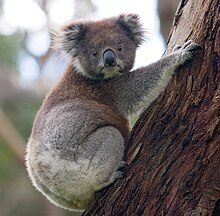Vombatiformes
| Vombatiformes Temporal range:
| |
|---|---|

| |
| Phascolarctos cinereus | |
| Scientific classification | |
| Domain: | Eukaryota |
| Kingdom: | Animalia |
| Phylum: | Chordata |
| Class: | Mammalia |
| Infraclass: | Marsupialia |
| Order: | Diprotodontia |
| Suborder: | Vombatiformes Burnett, 1830 |
| Families | |
| |
The Vombatiformes are one of the three suborders of the large marsupial order Diprotodontia. Seven of the nine known families within this suborder are extinct; only the families Phascolarctidae, with the koala, and Vombatidae, with three extant species of wombat, survive.
Among the extinct families are the Diprotodontidae, which includes the rhinoceros sized Diprotodon, believed to be the largest marsupials ever, as well as the "marsupial lions" Thylacoleonidae and "marsupial tapirs" Palorchestidae.
Classification
[edit]Suborder Vombatiformes
- Family †Thylacoleonidae: (marsupial lions)[3]
- Genus †Thylacoleo
- Genus †Priscileo
- Genus †Wakaleo
- Genus †Microleo
- Family Phascolarctidae: koala (one modern species)[4]
- Genus †Perikoala
- Genus †Madakoala
- Genus †Koobor
- Genus †Litokoala
- Genus †Nimiokoala
- Genus Phascolarctos
- Vombatomorphia
- Family †Wynyardiidae
- Genus †Wynyardia
- Genus †Muramura
- Genus †Namilamadeta
- Family †Ilariidae
- Genus †Koalemas
- Genus †Kuterintja
- Genus †Ilaria
- Vombatoidea
- Family †Mukupirnidae
- Genus †Mukupirna
- Family †Maradidae
- Genus †Nimbavombatus (either considered the most basal vombatid[2] or just outside Vombatidae[1])
- Family Vombatidae: wombats (three living species)
- Genus †Rhizophascolonus
- Genus Vombatus
- Genus †Phascolonus
- Genus †Warendja
- Genus †Ramsayia
- Genus †Sedophascolomys
- Genus Lasiorhinus
- Family †Mukupirnidae
- Superfamily Diprotodontoidea[6]
- Genus †Silvabestius
- Genus †Ngapakaldia
- Genus †Nimbadon
- Genus †Neohelos
- Family †Diprotodontidae:[6]
- Genus †Alkwertatherium
- Genus †Bematherium
- Genus †Pyramios
- Genus †Nototherium
- Genus †Meniscolophus
- Genus †Euryzygoma
- Genus †Diprotodon
- Genus †Euowenia
- Genus †Sthenomerus
- Subfamily †Zygomaturinae[6]
- Genus †Neohelos[6]
- Genus †Raemeotherium
- Genus †Plaisiodon
- Genus †Zygomaturus
- Genus †Kolopsis[6]
- Genus †Kolopsoides
- Genus †Hulitherium
- Genus †Maokopia
- Family †Palorchestidae: (marsupial tapirs)[6]
- Genus †Palorchestes
- Genus †Propalorchestes
- Genus †Pitikantia
- Family †Wynyardiidae
References
[edit]- Groves, C. P. (2005). Wilson, D. E.; Reeder, D. M. (eds.). Mammal Species of the World: A Taxonomic and Geographic Reference (3rd ed.). Baltimore: Johns Hopkins University Press. pp. 43–44. ISBN 0-801-88221-4. OCLC 62265494.
- ^ a b Beck, Robin M. D.; Louys, Julien; Brewer, Philippa; Archer, Michael; Black, Karen H.; Tedford, Richard H. (2020-06-25). "A new family of diprotodontian marsupials from the latest Oligocene of Australia and the evolution of wombats, koalas, and their relatives (Vombatiformes)". Scientific Reports. 10 (1): 9741. doi:10.1038/s41598-020-66425-8. ISSN 2045-2322. PMC 7316786. PMID 32587406.
- ^ a b Crichton, Arthur I.; Worthy, Trevor H.; Camens, Aaron B.; Yates, Adam M.; Couzens, Aidan M. C.; Prideaux, Gavin J. (2023-03-19). "A new species of Mukupirna (Diprotodontia, Mukupirnidae) from the Oligocene of Central Australia sheds light on basal vombatoid interrelationships". Alcheringa: An Australasian Journal of Palaeontology. 47 (4): 446–474. doi:10.1080/03115518.2023.2181397. ISSN 0311-5518.
- ^ Naish, Darren. "Of koalas and marsupial lions: the vombatiform radiation, part I". Scientific American. Scientific American, Inc. Retrieved 24 October 2015.
- ^ McKenna, Malcolm C.; Bell, Susan K. (1997). Classification of mammals – above the species level. New York: Columbia University Press. pp. xii–631. ISBN 9780231110129.
- ^ BLACK, K., March 2007. Maradidae: a new family of vombatomorphian marsupial from the late Oligocene of Riversleigh, northwestern Queensland. Alcheringa 31, 17-32. ISSN 0311-5518
- ^ a b c d e f Black, K. (2012). "Revision in the marsupial diprotodontid genus Neohelos: Systematics and biostratigraphy". Acta Palaeontologica Polonica. doi:10.4202/app.2012.0001.
| ||||||||||||||||||||||||||||
| ||||||||||||||||||||||||||||
Text is available under the CC BY-SA 4.0 license; additional terms may apply.
Images, videos and audio are available under their respective licenses.


